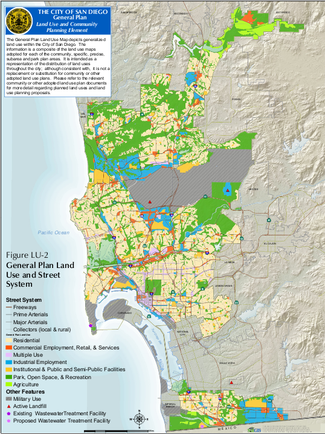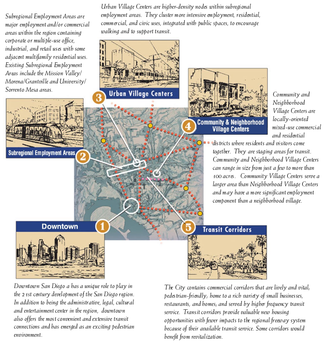
Reinventing the General Plan
A Project of the California Planning Roundtable
With support from the American Planning Association, California Chapter
Great Model: City of San Diego
Featured Principles: Create a Vision, Prioritize Action, Be Universally Attainable
- Context
- City of Villages
- Planning For Action
- Created Locally
- Challenges and Lessons
- Background Information
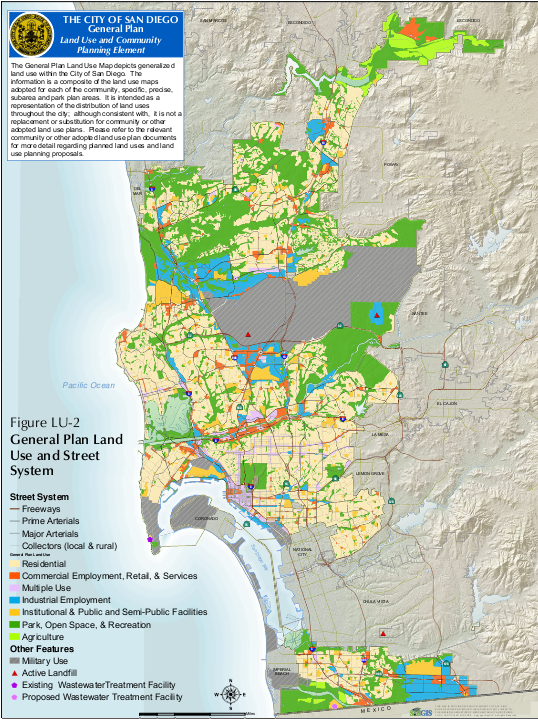
To comprehensively update its General Plan, the City of San Diego went through an extensive multilayered process that resulted in one of the more visionary, strategic, and hard-hitting General Plans in California. With its clarity of purpose and policy provisions, its cohesive and comprehensive organization, and its focus on real world implementation, the City of San Diego General Plan 2008 is an especially great model for communities seeking alternatives to expansion. The American Planning Association recognized this excellence by honoring the Plan with the 2010 National Planning Excellence Award for Comprehensive Planning. Here are but a few of its distinguishing characteristics:
-
Its near exclusive reliance on in-house preparation. A remarkable accomplishment in today's budget-challenged world, San Diego, California's second largest city, was able to prepare the General Plan relying almost exclusively on in-house resources with only minor supplemental consultant assistance.
-
Resolving “Guiding Principles” early in the process. Crucial to the success of the ultimate effort was the city's crafting of 10 principles, resolved early in the process, that guided the development of its General Plan document.
-
Embracing the “City of Villages” concept. The city made a conscious decision to move from an outward growth focus to one that looks inward, centered on the concept of Villages. While the General Plan had to make some midcourse corrections on how to designate “villages” in the community, the plan was able to define the attributes of villages and make the "city of villages" the central organizing concept of the General Plan. The villages are envisioned to be compact and walkable, to have a robust mix of uses focused upon transportation networks and to be defined by open-space networks.
-
Urban design as a driving force. To help ensure the quality of internal growth, the Plan strongly focuses on fostering attractive urban design throughout the city.
-
Protecting and enhancing its economy. The Plan was guided by a direction to enhance and protect of its economy. It limits conversion of nonresidential land uses to residential uses to preserve land for employment generating land uses.
-
A vigorous public engagement process. The city was exhaustive in educating and informing the public throughout the five-year period of developing the San Diego General Plan 2008. It also engaged and involved many other agencies and organizations within the region to develop its vision and the General Plan’s provisions for realizing that vision.
-
A strong focus on implementation. Perhaps one of the strongest features of the San Diego General Plan 2008 is its incisive, yet practical focus on realistic implementation and laying out a clear roadmap to achieving that vision through community plan updates, capital improvement programming, and future city budgets.
-
The use of redevelopment funds to update Area Plans. The City was able to make unique findings of benefit that have allowed redevelopment funds to fund all or portions of the 47 Area Plan updates that the City will undertake over time in implementing its General Plan.
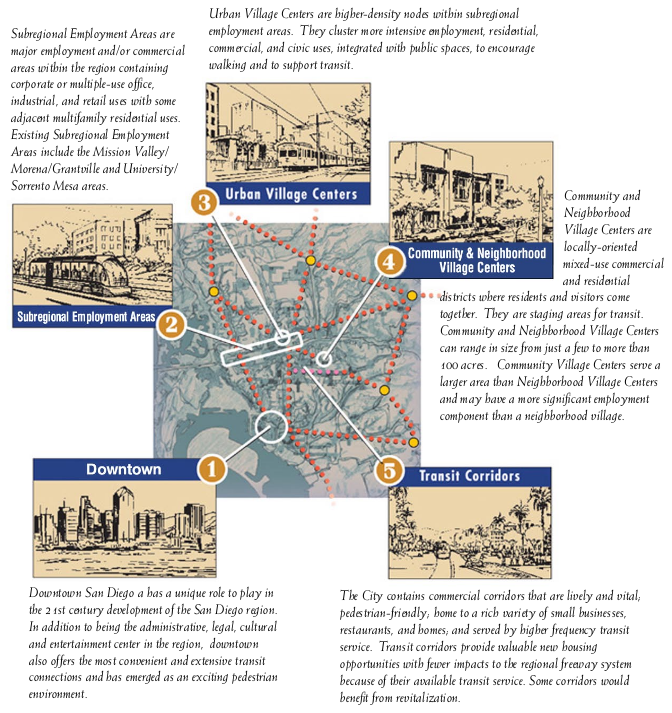
The City of San Diego General Plan 2008 plays a key strategic role in a major change in land use policy for San Diego, a bold vision that reverses the City's decades of outward expansion to a focus on looking inward. The City of Villages concept envisioned dozens of compact, walkable mixed-use nodes centered on the City's already existing community centers, connected by regional transit.
Like many such major changes in policy, the City of Villages concept took multiple steps and many years to envision, define, and implement, a process that is still ongoing.
The first step was the creation of a Strategic Framework Element, developed between 1999-2003 through multiple public forums and the work of a 40-person Citizen Committee. The Strategic Framework Element identified ten succinct Guiding Principles (listed below) which set forth the essential structure of San Diego's plan and reflected the core values that guided its development:
- An open space network formed by parks, canyons, river valleys, habitats, beaches, and ocean;
- Diverse residential communities formed by the open space network;
- Compact and walkable mixed-use villages of different scales within communities;
- Employment centers for a strong economy;
- An integrated regional transportation network of walkways, bikeways, transit, roadways, and freeways that efficiently link communities and villages to each other and to employment centers;
- High quality, affordable, and well-maintained public facilities to serve the City’s population, workers, and visitors;
- Historic districts and sites that respect our heritage;
- Balanced communities that offer opportunities for all San Diegans and share citywide responsibilities;
- A clean and sustainable environment; and
- A high aesthetic standard
The Strategic Framework Element also identified the characteristics of the Villages, as urban mixed-use infill and transit oriented development interconnected by transit hubs and open space networks.
The General Plan itself, developed from 2003-2008, further set the vision and policy framework for the Villages concept to proceed, incorporating the Strategic Framework Element and emphasizing urban design as a key element to assure the livability of the villages.
Yet the Strategic Framework Element and the General Plan 2008 stopped short of designating the actual locations of the Villages and deferred this step to the completion of dozens of Area Plans as extensions of its General Plan. This decision was reached during the comprehensive update early in the Strategic Framework process out of the concerns of community planning group members—a powerful local constituency in San Diego— that designating Village locations should not be pursued without a close-grained evaluation of how each Village might affect the community as a whole through the Community Plan update process. These community issues would be addressed in the Community Plan updates where the more precise issues of urban design, mobility, connectivity, community fit, infrastructure, local public outreach, and implementing the Land Development Code as the regulatory device are adapted to each unique area of the City.
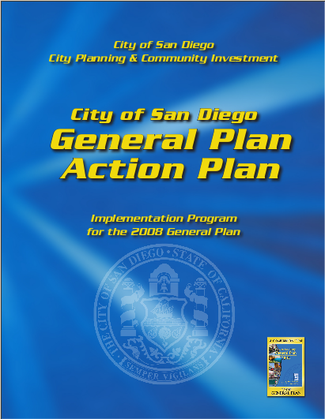
Following the adoption of the General Plan in 2008, the City prepared a separate document called the City of San Diego General Plan Action Plan, which is being used to comprehensively implement the General Plan over time. The Action Plan sets forth a clear roadmap to complete community plan updates, undertake climate change initiatives, pursue water supply and conservation efforts, process land development code amendments, resolve public facility financing strategies, prepare economic development strategic plans and a parks master plan, and initiate historic preservation zones. It is an unusually well considered and clearly communicated implementation plan.
The City is currently proceeding with its Action Plan in large part by incrementally updating the community plans for the City’s 47 planning areas. These Area Plans will address with more specificity the land-use, zoning, infrastructure, urban design, and public financing issues associated with each of those areas.
Each of these Area Plans is considered to an extension of the General Plan, as opposed to constituting Specific Plans, and will address the designation of “Villages” in the planning areas. They are expected to reflect the vision set forth in the General Plan, ensure consistency with the City’s land use policies, and create a viable plan to support the localized business community, improve mobility, facilitate appropriate development, and adequately provide for public infrastructure and facilities in each planning area. The Area Plans are intended to provide more flexible, hard hitting, on-the-ground results than might be provided by rigid Specific Plans.
Fiscal year 2009-2010 has been a frenetic period that has witnessed the City working on 14 Area Plans in various stages of completion. Some are nearing completion, some have just started, and some are in the middle of production. A city website provides a great deal of information about the Area Plans.
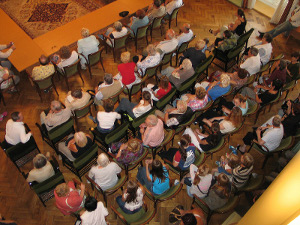
Between its nearly entirely in-house preparation and vigorous public outreach efforts, the San Diego General Plan 2008 demonstrates a remarkable engagement of the local community in creating a General Plan. This engagement continues as the City works on its first Area Plans. A useful website provides documents, explains policies, and keeps residents abreast of the latest developments and opportunities to participate in shaping their communities. For a city characterized by many distinct neighborhoods, San Diego was able to find a way to make everyone's voice heard. The city also creatively used redevelopment funds to complete portions of the planning process.
The public outreach process and the City's financial and political support for preparing its General Plan in-house were critical to its success, coupled with the savvy and activism of San Diego's citizenry on planning issues. These attributes clearly prepared and provided the City with a strong foundation for the success of its General Plan update.
The rationale for preparing the San Diego General Plan 2008 in-house was twofold:
-
To recognize that existing staff would be expected to implement the General Plan and that it was essential for that staff to fully understand the ins and outs of the General Plan process to do so.
-
To utilize existing staff and budgeted positions in the City Planning and Community Investment Department, and to save public funds that would otherwise have to come out of the General Fund to pay for consultants.
The public participation process involved ongoing direct e-mail communications with over 2700 contacts, televised public forums, and over 250 public meetings and workshops involving decision-makers, business interests, stakeholders, and the general public. This was in addition to dozens of working group meetings with the City's Community Planners Committee - a group comprised of the chairpersons of the city's 43 Community Planning Committees, from all of the City's unique communities. This process proved to be a critical component of the City’s successful effort. As a result of these efforts, the plan received widespread public support at public hearings and the City Council adopted the plan unanimously in May 2008.
A further distinguishing feature of the Plan is that nine of the Area Plan updates currently underway are being funded, in whole or or in part, through the use of redevelopment funds. The use of these funds, combined with general funds and grants, for areas that include redevelopment project zones, is a reflection of the City’s support for its Planning and Community Investment Department. However, with the State’s intentions to seize local redevelopment funds to shore up its budget crisis, this strategy may be somewhat at risk.
The principal challenges the City faced centered on infrastructure issues, a limited budget, the need to provide protections for the City’s distinctive neighborhoods and historical resources, and getting the community used to the notion of encouraging mixed-use infill and transit-oriented development at a time when transit funding was decreasing. Indeed this latter issue was addressed early in the process when the City decided to postpone the designation of villages under its “City of Villages” concept. Instead of being part of the General Plan, the designation of villages was deferred to the planning process associated with the completion of the community plans. This strategic decision defused this principal controversy during the update process and allowed for the smoother processing of the foundational documents of the San Diego General Plan.
Additionally, the City saw some major turnover in its staff and political leadership during the Plan's creation. Fortunately, strong leadership prevailed and the Plan was ultimately only delayed by about one year.
Planning staff did note that the most important lesson learned was that it was not necessary to divide the Strategic Framework Element that preceded the General Plan Update; staff felt that both could have been accomplished at the same time,saving money and time. From start to finish, updating the general plan took nine years. On the other hand, developing an early consensus around the guiding principles to the General Plan Update early in the process may have contributed to its eventual success.
As for the "transferability" of San Diego's experience to other jurisdictions, its ability to come out of the process with a strong consensus on embracing mixed use infill was exemplary. While the concept of city-centered growth is being advocated throughout the state as a key component of long-term sustainability, there remains significant resistance in many of California's communities to accepting higher densities in their urban fabrics. San Diego's strong history of investment in planning, the sophistication of its citizenry on growth and development issues, and the City's ongoing efforts at public engagement in implementing its General Plan 2008, through Community Plan Updates and its Action Plan, all clearly contributed to the success of this update process. Whether other jurisdictions can emulate the success of San Diego will depend on their level of commitment and investment in planning, the resolve to educate and involve their citizenry with sincerity over the long term, and the courage of their community leaders to act proactively and decisively.
Community Description
With a diverse population of 1.3 million people, The City of San Diego is the second largest city in California, covering over 300 square miles and stretching nearly 40 miles from north to south at the Mexican border. The City has experienced significant growth as well as two serious recessions in recent years, and is dealing with an aging population and decline of middle-income jobs. Its economy is marked by a mixture of high-tech, military, tourism/convention, and low-wage industries.
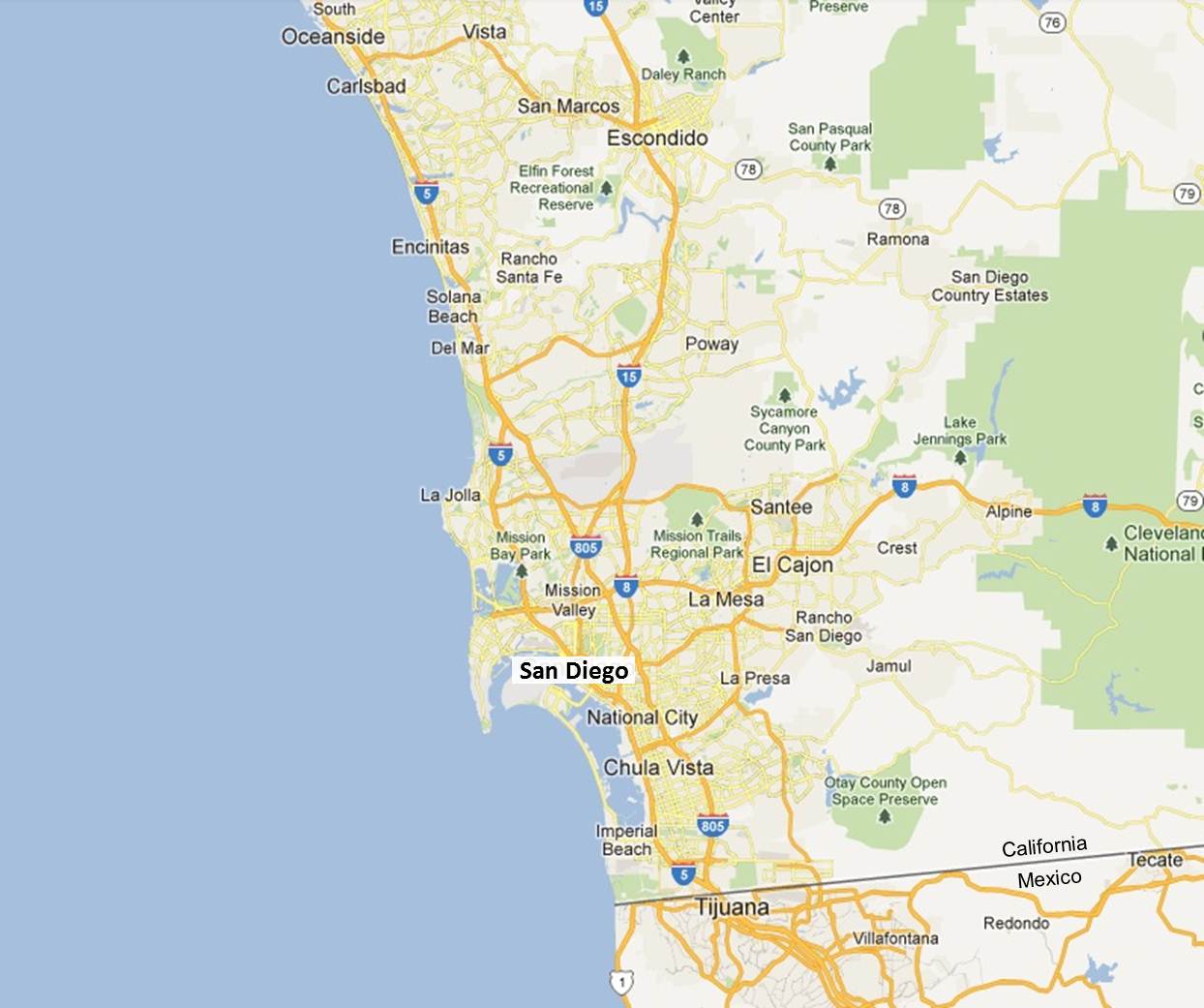
Defined by a unique and varied topography of mesas, canyons, and creeks, the City's expansionary past seems to be meeting its limits as residential development meets its jurisdictional boundaries and local citizenry demand change through numerous ballot box initiatives and programs including the Urban Form Action Plan, the Regional Growth Management Strategy, the Livable Neighborhoods Initiative, Towards Permanent Paradise and the Renaissance Commission report.
Timeframe of Plan Development
The City of San Diego General Plan 2008 was the culmination of a nine-year process to update the City's aging General Plan, last comprehensively updated in 1979. In completing its General Plan Update, the City went through a process of preparing a sequence of three primary work products:
-
The Strategic Framework Element that outlined The “City of Villages” concept as well as the “Core Values” that became the foundation for the General Plan. This product was developed between 1999-2002 in collaboration with multiple public forums and a 40 person Citizens Committee to resolve and set forth the policy framework that would guide the development of the General Plan.
-
The City of San Diego General Plan 2008 document itself which was developed over the period from 2003 to 2008. The General Plan was unanimously adopted by the San Diego City Council in 2008. The Strategic Framework Element was rescinded with adoption of the 2008 plan. The essential policies were incorporated into the various elements of the General Plan, and a Strategic Framework chapter (not an element) was included as an introductory Executive Summary of the General Plan.
-
The City of San Diego General Plan Action Plan which was developed between 2008 through 2009 that represents a comprehensive approach to implementing the General Plan over time. The Action Plan was unanimously adopted by the City Council in July 2009.
Keeping On Schedule
The General Plan process overall adhered to schedule, although with its many components, it has been in development for nine years, and the process continues with the creation of Area Plans.
Due to a change of Planning Directors in 2005, there was an approximately a one-year gap where things slowed down on the update process that was supposed to have been concluded by the spring of 2007. As comprehensive General Plan Updates go, this was not an inordinate delay but an understandable one given the turnover in key staff, Council-members, and the Mayor’s office.
Community Reaction
The plan appears to enjoy very strong public support, and it will be valuable to see how that support translates into the completion of the community plans that are moving forward as part of the implementation of General Plan. The continual process of updating community plans throughout the City will keep the General Plan relevant well into the future.
Public Participation & Stakeholder Involvement
See Created Locally, above.
Other City Departments' Involvement
In addition to the staff of the City Planning and Community Investment Department, just about every department in the city was involved in some form in the General Plan Update, including the Department of Development Services, the Commission for Arts and Culture, the Engineering and Capital Projects Department, the Department of Environmental Services, the Department of Fire Rescue, the Department of Homeland Security, the Library Department, the Metropolitan Wastewater Department, the Parks and Recreation Department, the San Diego Police Department, the Water Department, and a wide variety of participating boards and commissions for the City of San Diego.
Legal and Policy Context
The main impetus for pursuing the General Plan Update was to update its aging 1979 General Plan and to transition San Diego from an outwardly expanding community, into one that focused upon spurring urban mixed-use infill development centered upon transit hubs and separated by open space networks. The General Plan and its EIR also address the issues of sustainability and greenhouse gases, and the City consulted with the state Attorney General’s office, receiving a clean bill of health for the Plan before it was adopted.
Connections to Jurisdictional Budget
The Action Plan of the San Diego General Plan 2008 clearly sets forth its importance as a living, breathing component that will fully guide the implementation of the General Plan through the City's Capital Improvement budget. Each community plan has an associated Public Facilities Financing Plan that provides the strategy for funding community infrastructure and facilities, and is the basis for establishing the nexus relationship for Development Impact Fees and Facilities Benefit Assessments. The CIP budget is annually reviewed for conformance with the General Plan, and projects within the CIP must be consistent with a community plan and the General Plan. However, the General Plan documents themselves and Action Plan do not drive the annual budget process.
Are the Plan's features easy to use by the public and the staff?
Yes. The writing is clear, free of jargon, and easy to comprehend. Furthermore, by continuously providing updates to its extensive database of contacts, the City ensures that the public will remain informed about the General Plan and its implementation.
Graphics and Presentation Qualities of the Plan
The General Plan, its Executive Summary, the Strategic Framework Element, and the Action Plan are all hands-on documents with clear graphics and crisp sketches and images that highlight constituent parts of the plan. (See below for links.)
Organization of Elements
While the General Plan contains some of the typical elements, they have been given different titles and incorporated into San Diego’s own customized list of elements. Of the conventional elements mandated by the state's General Plan law, the City's plan contains a Land-Use and Community Planning Element; a Mobility Element which takes the place of the Circulation Element; a Public Facility, Service and Safety Element; a Housing Element; a Conservation Element; an Open Space Element; and a Noise Element. The Plan also contains an Urban Design Element, an Economic Prosperity Element, a Recreation Element, and a Historic Preservation Element.
Although this list of elements may seem to be at variance with the state’s general plan law, the City provided a matrix in the Plan's first appendix, outlining how these elements comply with the mandatory elements of State law (see the image at the top of this tab).
Consideration of Regional Issues
The City Planning and Community Investment Department made an extensive effort at regional planning and inter-jurisdictional coordination. It closely coordinated with the County of San Diego, the San Diego Unified Port District, the San Diego Association of Governments (SANDAG), the San Diego County Regional Airport Authority, tribal governments, and other local governments throughout the region. The City also worked consistently with state and federal representatives on legislative, regulatory, and budgetary matters and with its counterparts in Mexico. The Mobility Element of the Plan, which contains provisions for the mandated Circulation Element in General Plan law, was extremely important, and a strategic planning framework was provided by the Regional Comprehensive Plan as approved by the SANDAG Board of Directors. Finally, one look at the “acknowledgments” pages show the sheer volume of contacts with agencies, organizations, and individuals with whom the City collaborated in completing its General Plan update.
Actual Costs
Because the vast majority of planning effort was conducted utilizing in-house salaried personnel, the Planning Department could not provide an estimate of the total cost, in dollars, to prepare the various products that constitute the San Diego General Plan 2008. They were able to estimate they had spent approximately $150,000 for the work of the environmental consultants to provide guidance on the EIR preparation for the Plan, which was already covered by the departmental budget combined with a disbursement from the City’s General Fund to cover the its relatively small costs. The city was able to provide an estimate of the level of effort in the form of the number of Full Time Equivalent (FTE) staff that was devoted to the update as outlined below:
From 2003-2008 (5.25 years) average staffing was:
4.5 FTE: Planning Staff (GP planners, park planners, engineers, environmental analysts)
0.6 FTE: Support Staff (word processing, web postings, admin)
0.3 FTE: Graphics and Mapping Staff (GIS, photos, graphic design)
By contrast, the completion of the Area Plan Updates has been more dependent upon Redevelopment funding. Special findings of benefit were made by the City in appropriating Redevelopment funds and the amount of redevelopment funds being used varies. For those Area Plans that are contained within Redevelopment Project Areas or that have smaller Project Areas that dominate the planning issues associated with that Area Plan, the updates are entirely financed by Redevelopment funds. For those areas that have smaller Project Areas that do not dominate those planning areas, redevelopment funds finance only a proportional share of the expenses in combination with a General Fund appropriation and a locally collected General Plan Maintenance fee. For those Area Plans where there are no Redevelopment Project Areas, no Redevelopment funding is used.
Actual Costs vs. Expected Costs
Because the City Planning & Community Investment Department used an internal team of existing personnel to prepare the General Plan update, it does not appear that any in house budget was set for the completion of that update in-house other than the amount spent on the environmental consultants and printing costs.
The costs associated with the Area Plan updates will vary. The two Area Plans that are ready to get underway in late 2009 – the San Ysidro and the Midway/Old Town San Diego Area Plan Updates – have been budgeted for $2,000,000 and $1,600,000 respectively of Redevelopment Agency funds. Of these totals, approximately $650,000 to $850,000 has been set aside for consultants to assist in preparing each of these updates. The remainder is reserved for economic analysis, CEQA compliance, infrastructure implementation, and staff administration of the process.
Accessing the Plan
The various documents that comprise the City of San Diego's General Plan 2008 are addressed in three volumes:
-
The Strategic Framework Element, which sets forth the "City of Villages" concept and a list of 10 principles that guided the development of the General Plan.
-
The City of San Diego General Plan 2008 document itself (downloadable by chapter)
-
The City of San Diego General Plan Action Plan, which serves as the implementation program for the 2008 General Plan.
-
Information the continuing process of Area Plans is accessible at the Community Planning website.
Planning Staff and Consultants
The in-house person responsible for overseeing the completion of the General Plan was William Anderson, FAICP, who serves as Executive Director of the City Planning and Community Investment Department for the City of San Diego. Heading the General Plan team was Nancy Bragado, Principal Planner, who managed a staff of between three and six people throughout the update effort. The acknowledgments pages to the General Plan lists revealed that 18 staff members were directly involved in preparing the General Plan.
The only consultant that appears to have been used in updating the General Plan was EDAW, which assisted with the the City primarily with air quality and greenhouse gas issues associated with the Plan's Environmental Impact Report. By contrast, the completion of the Community Plan updates to implement the General Plan throughout the 47 planning areas will depend on greater consultant assistance, particularly in the areas of urban design, public outreach, mobility and utility infrastructure analysis, economic analysis, and environmental evaluation.
Name of CPR Preparer of this Model
T. Keith Gurnee, Principal, RRM Design Group
Name of Primary Point of Contact(s) at the Jurisdiction
Bill Anderson, Executive Director of the City Planning and Community Investment Department, and Nancy Bragado, AICP, Principal Planner of the City Planning and Community Investment Department who served as the staff leader of the update process.
CPR Peer Reviewers
David Booher, Cathy Creswell, Linda Dalton, Al Zelinka
CPR Project Team
Elaine Costello, Project Manager; Co-Chairs Cathy Creswell and Janet Ruggiero; Craig Beebe, Project Assistant
Funding
California Chapter of the American Planning Association
http://www.calapa.org
The Catalog
Our catalog contains a number of General Plan "Great Model" examples. Browse the entire catalog
Browse by Principle
- Create a Vision
- Manage Change
- Make Life Better
- Build Community Identity
- Promote Social Equity and Economic Prosperity
- Steward and Enhance the Environment
- Engage the Whole Community
- Look Beyond Local Boundaries
- Prioritize Action
- Be Universally Attainable
Browse by tag:
awards city climate-change context county equity graphics growth-management health implementation infill mature-community organization participation preservation redevelopment region rural smart-growth suburban sustainability town urban urban-design web-strategies
